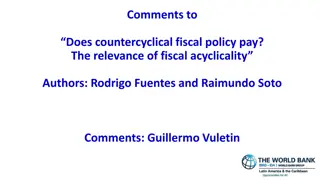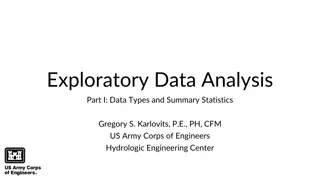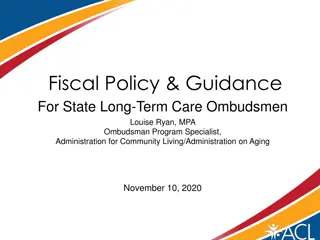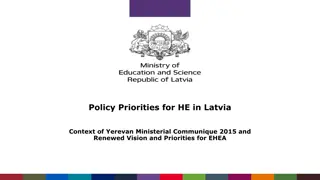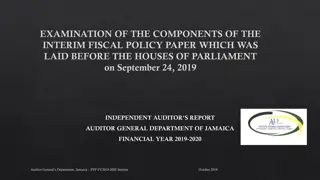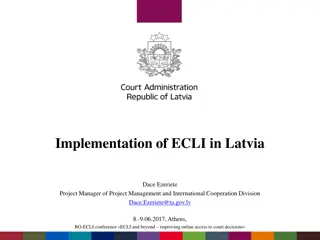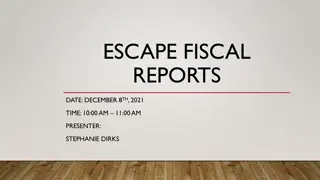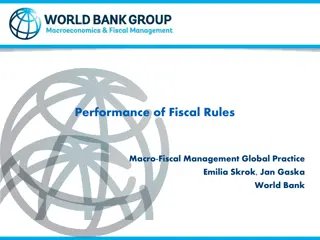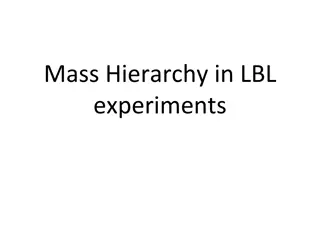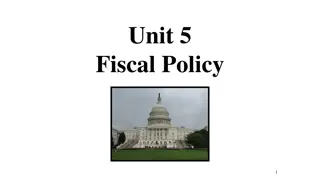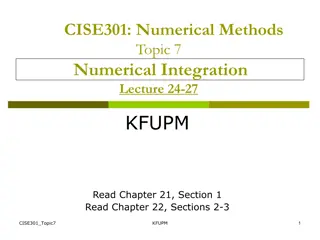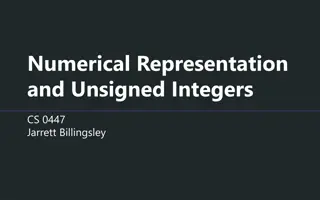Fiscal Framework in Latvia: Hierarchy of Laws and Numerical Rules
Fiscal framework in Latvia is governed by a structured hierarchy of laws focusing on fiscal discipline and numerical rules to ensure financial stability and accountability. Key components include the Fiscal Discipline Law, Medium-Term Budget Framework, and Annual Budget Law. These laws outline regulatory measures such as structural balance requirements, expenditure growth rules, and the interaction of fiscal numerical rules. The implementation of these rules is pivotal in maintaining a balanced budget and sustainable fiscal policy in Latvia.
Download Presentation

Please find below an Image/Link to download the presentation.
The content on the website is provided AS IS for your information and personal use only. It may not be sold, licensed, or shared on other websites without obtaining consent from the author.If you encounter any issues during the download, it is possible that the publisher has removed the file from their server.
You are allowed to download the files provided on this website for personal or commercial use, subject to the condition that they are used lawfully. All files are the property of their respective owners.
The content on the website is provided AS IS for your information and personal use only. It may not be sold, licensed, or shared on other websites without obtaining consent from the author.
E N D
Presentation Transcript
1 Fiscal Framework in Latvia NILS SAKSS DIRECTOR OF DEPARTMENT MINISTRY OF FINANCE
Hierarchy of Laws 2 Fiscal Discipline Law Law of Budget and Finance management Medium Term Budget Law Annual Budget Law
3 Fiscal Discipline Law
Architecture 4 Numerical fiscal rules Fiscal Discipline Law (FDL) Top down fiscal planning Medium term Budget Framework Law (MTBFL) 3 years fiscal framework Annual budget Annual Budget Law
Fiscal Discipline Law 5 Enactment Main elements Entered into force: 06.03.2013; Applicable starting from 2014-2016 MTBF; Impact on budget laws from 2014. Transitional provisions: Numerical Fiscal Rules; Fiscal Risks; Fiscal Council. Declaration of Fiscal Risks (DFR): from 2015-2017 MTBF; Fiscal Safety Reserve: 2014: 0; 2015: 0; 2016: 0,1%; 2017 and onwards: according DFR; Expenditure smoothing of EU Funds: from 2016; Expenditure smoothing of government debt service : from 2017; Fiscal Council : from 01.01.2013.
3 Numerical Fiscal Rules 6 Cyclical part Structural balance One-off measures Balance rule = + + Expenditure growth rule Expenditure growth ( net GDP deflator): not more than the average potential GDP growth. Expenditure ceiling Fixed in MTBFL for each of next 3 years. Operational tool for preparation of Budget Law ( stabilization, equalization, exceptions).
FDL: interaction of fiscal numerical rules (1) 7 Not less than minimal allowed structural balance -0,5% = MTO Government decision of size of structural balance (structural balance target (SBT)) Calculation of balance Calculation of cyclical component Adding one - off measures Net of local government projected balance Net of projected balance of derived public bodies Net of ESA corrections Central Calculated CG expenditure ceiling (1) Central government revenue projections - government fiscal balance =
FDL: interaction of fiscal numerical rules (2) 8 GG ESA expenditure in previous year Permissible expenditure growth Calculated GG ESA expenditure ceiling Net of ESA expenditure corrections Calculated CG expenditure ceiling (1) Net of local government projected expenditure Calculated expenditure ceiling min Net of derived public bodies projected expenditure Calculated CG expenditure ceiling (2)
FDL: interaction of fiscal numerical rules (3) 9 Inherited ceiling from previous MTBF 2nd and 3rd year difference < 0,1% GDP difference Expenditure ceiling in MTBF for the 1st and 2nd year difference > 0,1% GDP Calculated ceiling Expenditure ceiling in MTBF for the 3rd year
Max permissible CG expenditure Max. permissible CG expenditure may differ from CG expenditure ceiling due to allowed modulation. 10 Debt service smoothed expenditure EU projects smoothed expenditure CG adjusted expenditure CG expenditure ceiling = - - Actual debt service expenditure Actual EU projects expenditure CG adjusted expenditure = + + Max. permissible CG expenditure Fiscal Risk expenditure covered by FSR expenditure under Escape Clause Fiscal Safety Reserve (FSR) balance neutral expenditure - + + +/- + special one off (court ruling)
Escape clauses 11 Natural catastrophes, disasters and other material losses caused by natural or social processes. (>0,1% GDP); In case of threat to national security according to article 62 of Latvian Constitution; In case of severe economic downturn (recession). 1. 2. 3.
Fiscal risk management 12 Fiscal risk management: Regular identification, disclosure and mitigation; Declaration of fiscal risks annexed to MTBFL; Fiscal safety reserve: ( expenditure ceiling in MTBFL expenditure in Budget Law) depending of fiscal risks, at least 0,1% of GDP.
Modulation 13 = In each single year In long term Max. permissible CG expenditure CG expenditure ceiling = In each single year In long term Projected structural balance Structural Balance Target First defense line Second defense line 1. Expenditure smoothing 2. Fiscal safety reserve Automatic correction mechanism
Automatic correction mechanism 14 (based on Swiss debt break rules) notional account registering deviations of actual structural balance (+/-) from its planned targets. If cumulative deviation is negative and higher than 0,5%, correction is triggered automatically by improving structural balance in next MTBF by extra 0,5% until deviation is fully compensated.
Fiscal Council 15 http://fiscalcouncil.lv/council Fiscal Council: main task - monitoring implementation of fiscal rules. No direct mandate for independent macroeconomic forecasts, (in meaning of producing or endorsing macroeconomic forecasts), however will provide its opinion, which is not binding. issuing annual report and irregularity reports; Government response: comply or explain; 6 members; independence safeguards (removal from office, financing).
Fiscal Council (2) 16 Fiscal Council is independent collegiate institution established for the purpose of monitoring of the compliance with this Law. status Council consists of six members; 1) three members of Council are nominated under the joint proposal of president of Bank of Latvia and minister of finance; 2) three members of Council are nominated by at least ten members of the Parliament. Members of Council shall be experts in financial and economical field from Latvia or from other member state of the European Union with experience in fiscal policy issues. composition Members of Council shall be elected by Parliament for six years. The same member of Council shall be reelected not more than twice in consecutive order. appointment
Financial safeguard mechanism 17 Hourly salary rate for Council members is determined by applying a coefficient 0.056 to the amount of the average monthly remuneration. salary Operational expenditure of the Council shall be planned by Ministry of Finance in separate budget programme under Ministry of Finance prescribing: 1) remuneration of members of the Council for at least six meetings per year, inter alia for at least eight hours for preparation for each Council meeting; 2) remuneration for Secretary of the Council; 3) expenditure for external experts not less than 50 percent of the Councils members and Councils Secretary remuneration fund; 4) compensation of travel expenses and accommodation budget
Fiscal Space 18 If positive fiscal space is projected, the procedure for new policy initiatives is launched Fiscal Discipline Law Max. permissible CG expenditure Fiscal space - + + = Previous year CG expenditure one off expenditure n-1 adjustments of automatic mechanisms one off expenditure n Budget bases
New policy initiatives 19 After government take a decision to launch new policy initiatives : 1. Each ministry may submit a proposal for new policy initiatives ; 2. Proposals are evaluated by cross-sectoral coordination unit and Ministry of Finance. 3. Evaluations are made against approved development programmes. 4. All proposals are ranked and presented to the government. Government decided to fund measures ranked highest. In theory Decisions are political taking into account political pressures and governments own perception of most important measures. In praxis
Maximum permissible amount of the State budget expenditure (bottom- up) 20 For each ministry maximums permissible expenditure has been determined (bottom up). maximum permissible expenditure approved new policy initiatives budget basis
MTBFL 21 Structural balance targets have been set for 2016;2018;2018 (-0,9;-1,0;-0,8) CG adjusted expenditure 2016;2018;2018
MTBFL annex 22 Top down (Max. permissible CG expenditure) Free fiscal space CG expenditure ceilings in MTBFL Initial fiscal space Bottom up (CG expenditure under no change policy) Budget basis
Example of how max. permissible expenditure has been determined 23 2014 2015
Main Challenges Ahead 24
Vision 25 Present Each year ministries struggles for funds. Good minister is minister who gat more money to his sector Future Expenditure for each ministry growing according specific formula. Good minister is minister who get better results with funds available. No direct link of development programmes and the funds The reserve has been allocated to support new programmes. Programmes are approved only if funds are allocated. the thoughts are occupied how to satisfy the next year funding needs Focusing on medium and long term strategies some GG sub sectors out of fiscal control Fiscal solidarity principle implemented Weak understanding of GG ESA methodology General Government accrual reporting is understood by civil servants and politicians.
Open questions 26 What is a role of rules in budget planning in your country; Budget preparation political tool or rules based process what balance is desirable and realistic? How to convince politicians to use more rules in budget planning? Complexity of rules can it be avoided? 1. 2. 3. 4.
27 End of presentation


